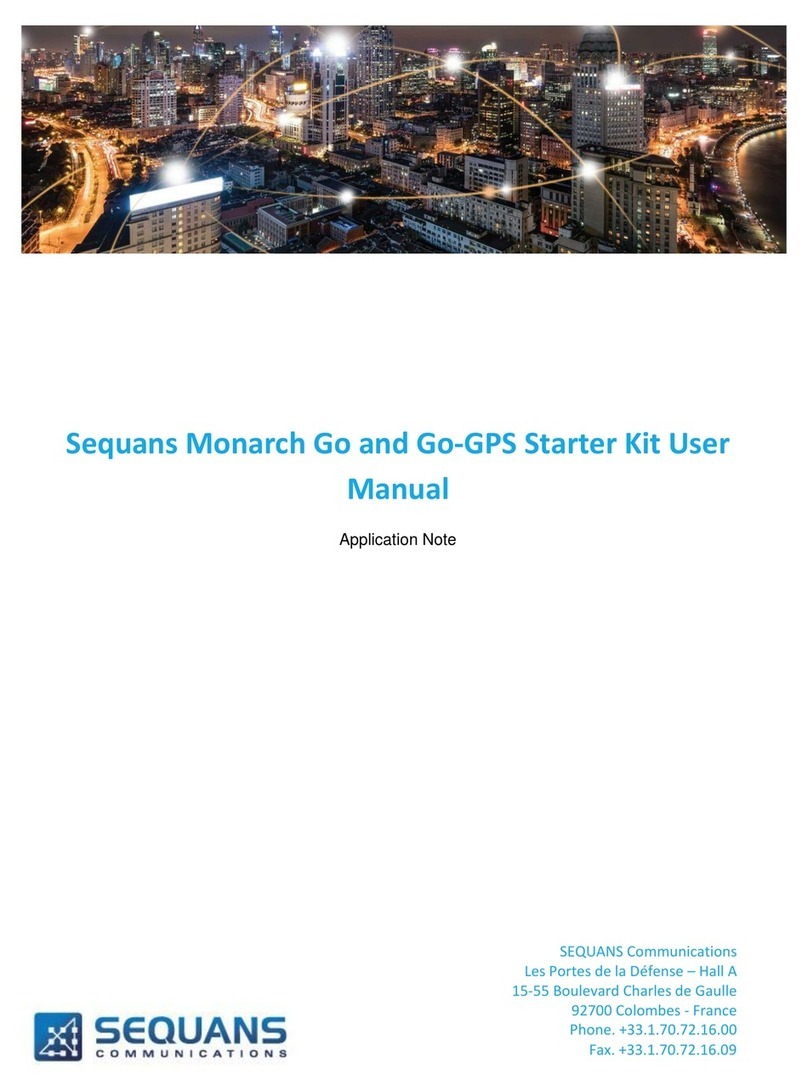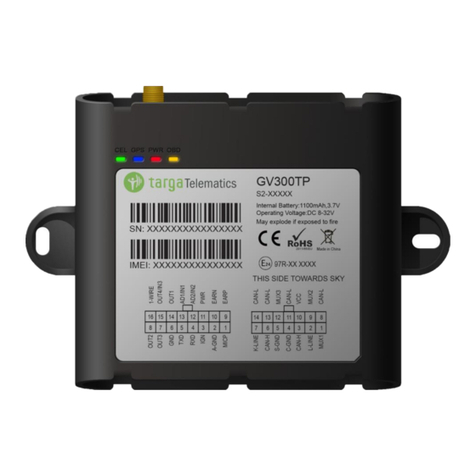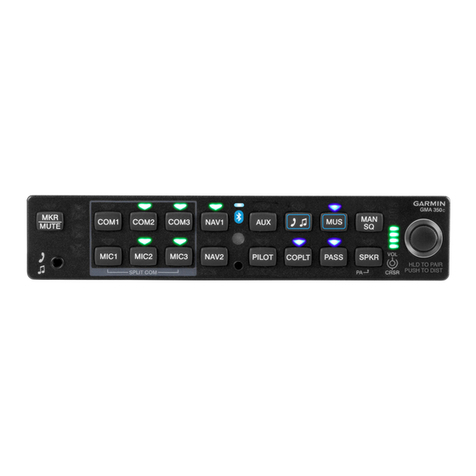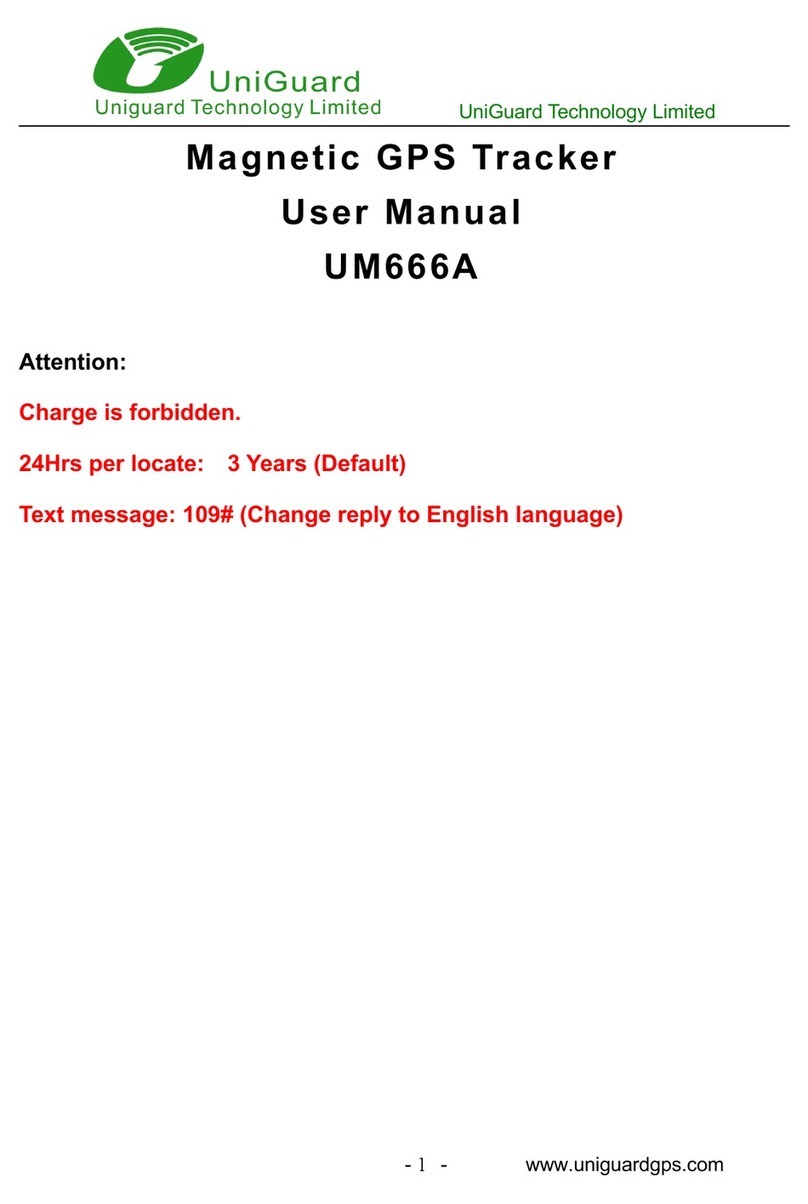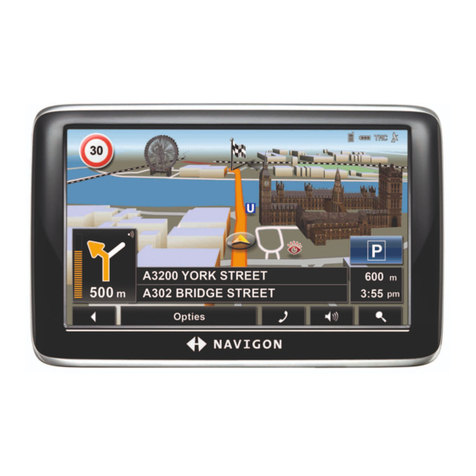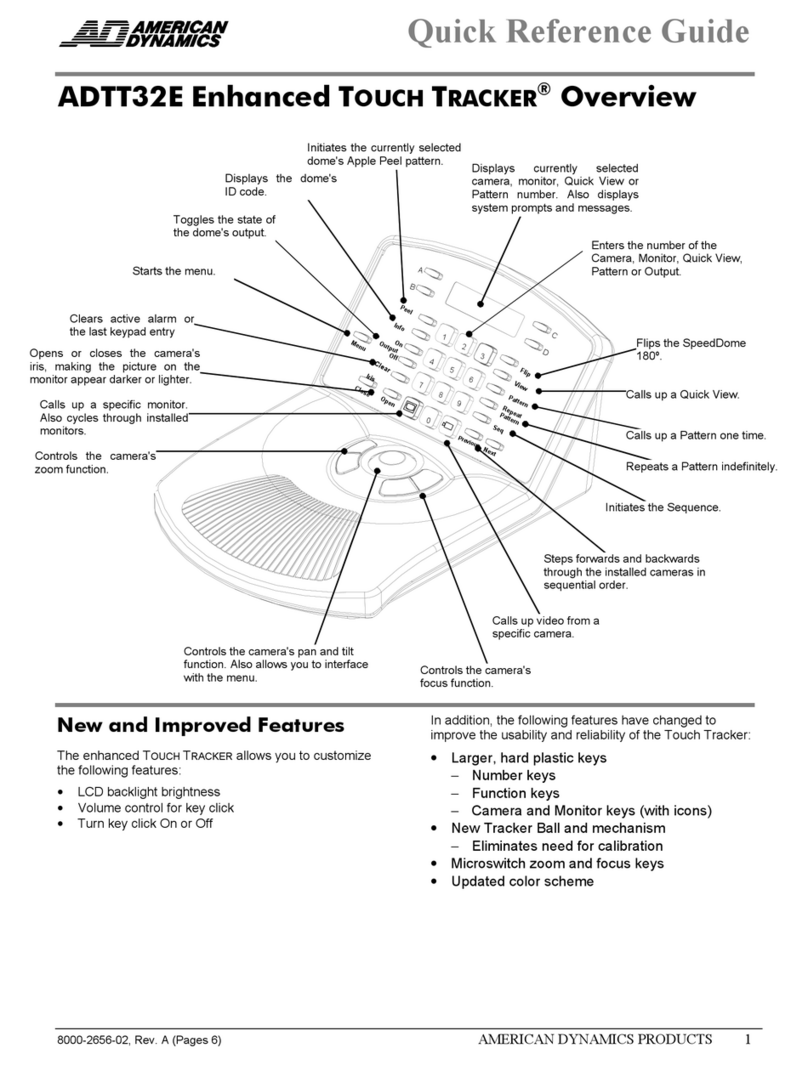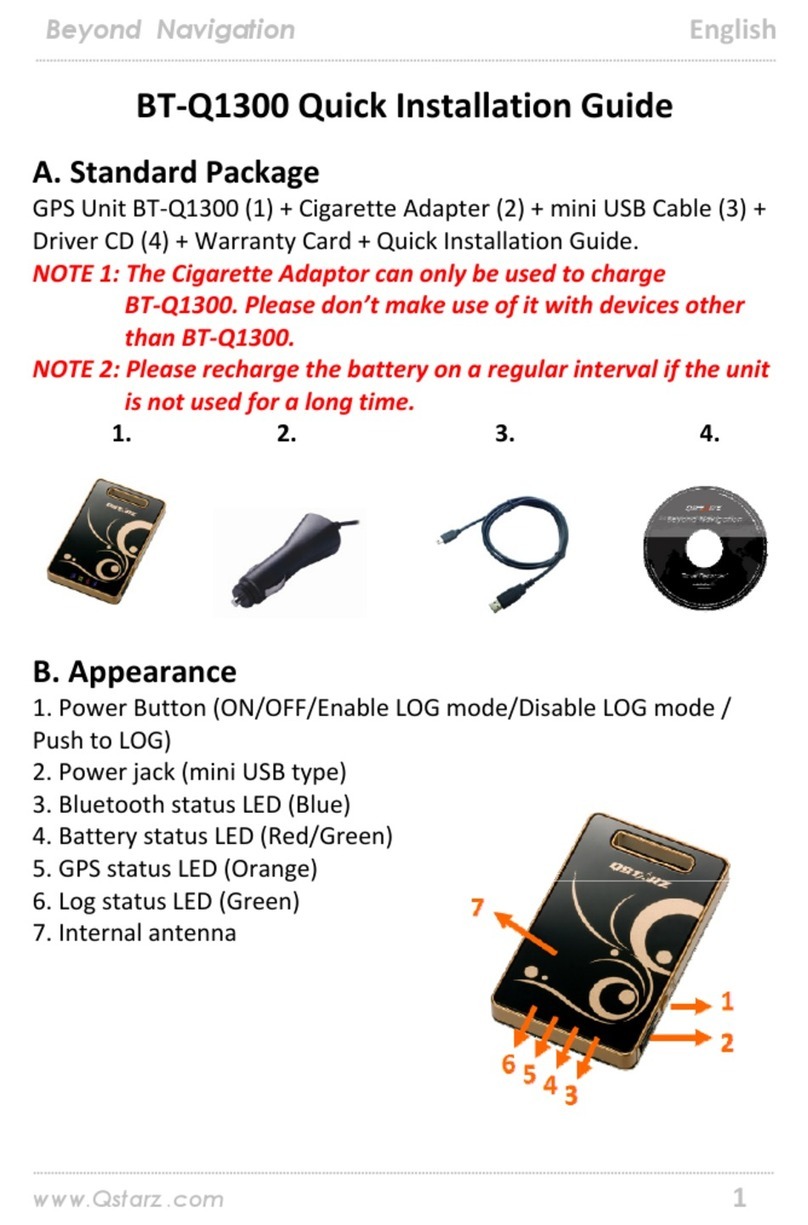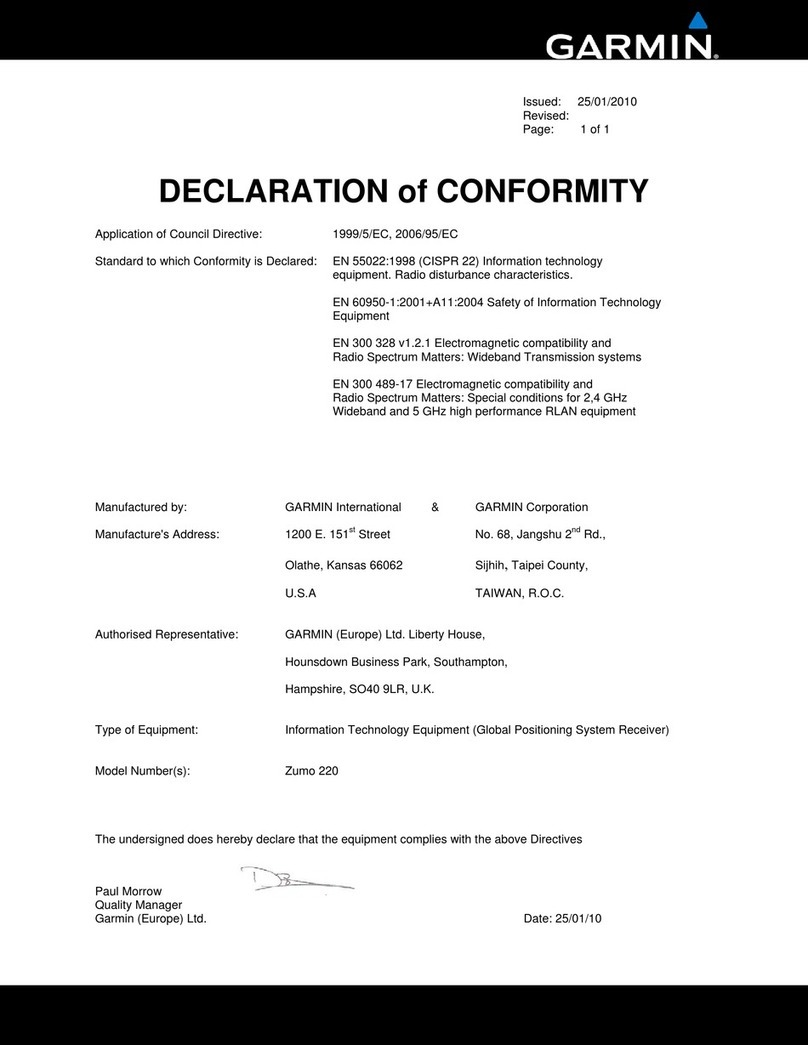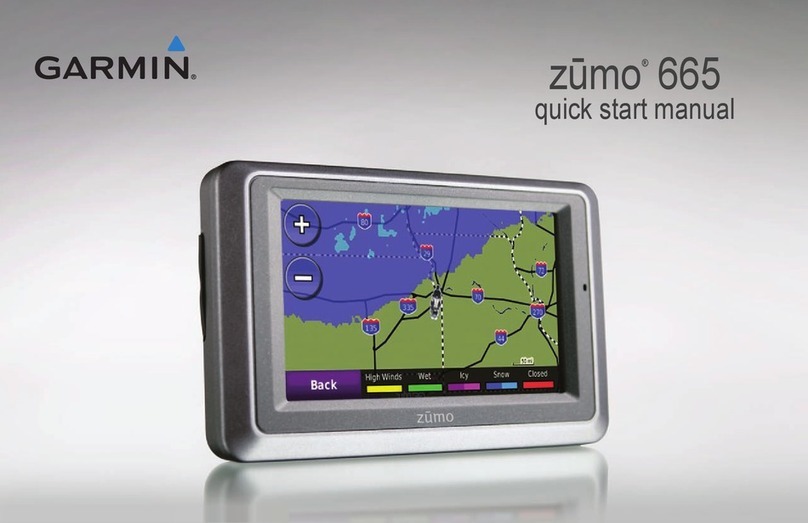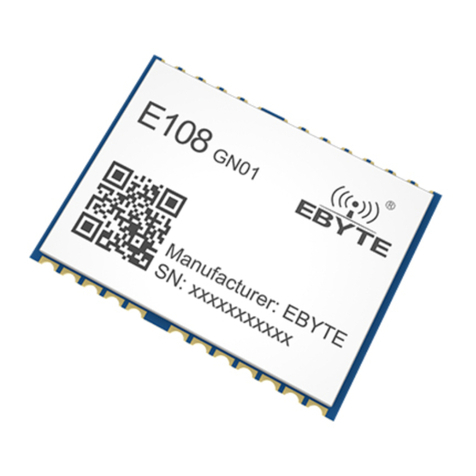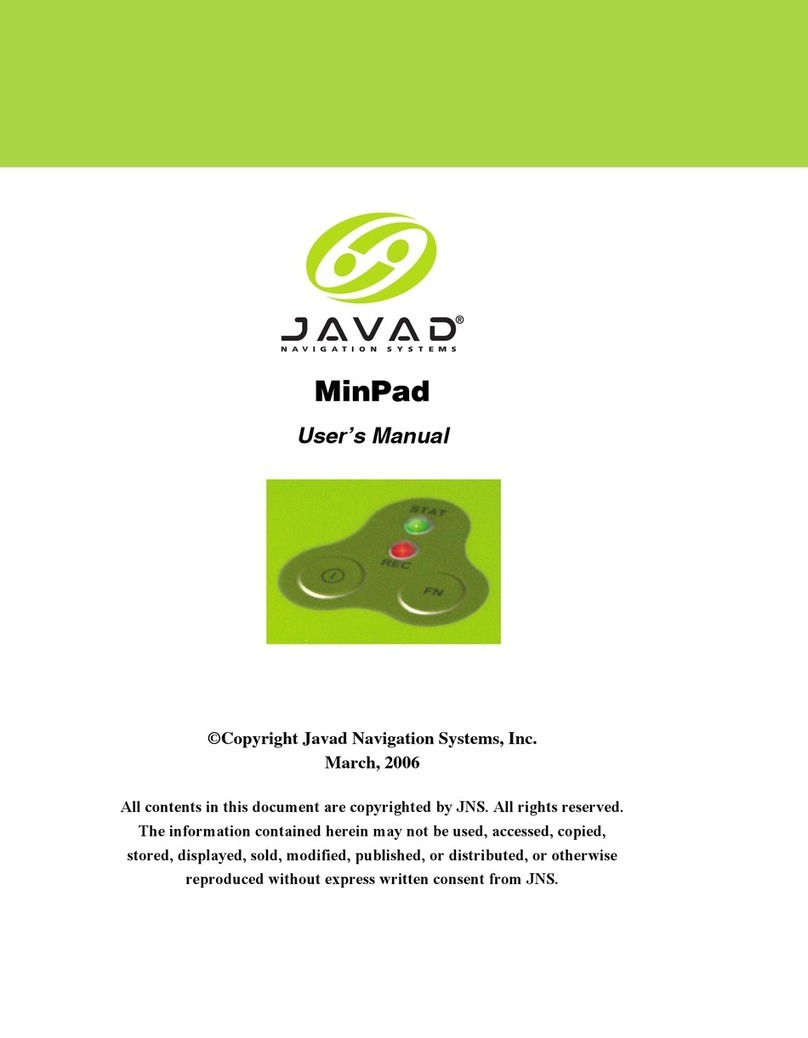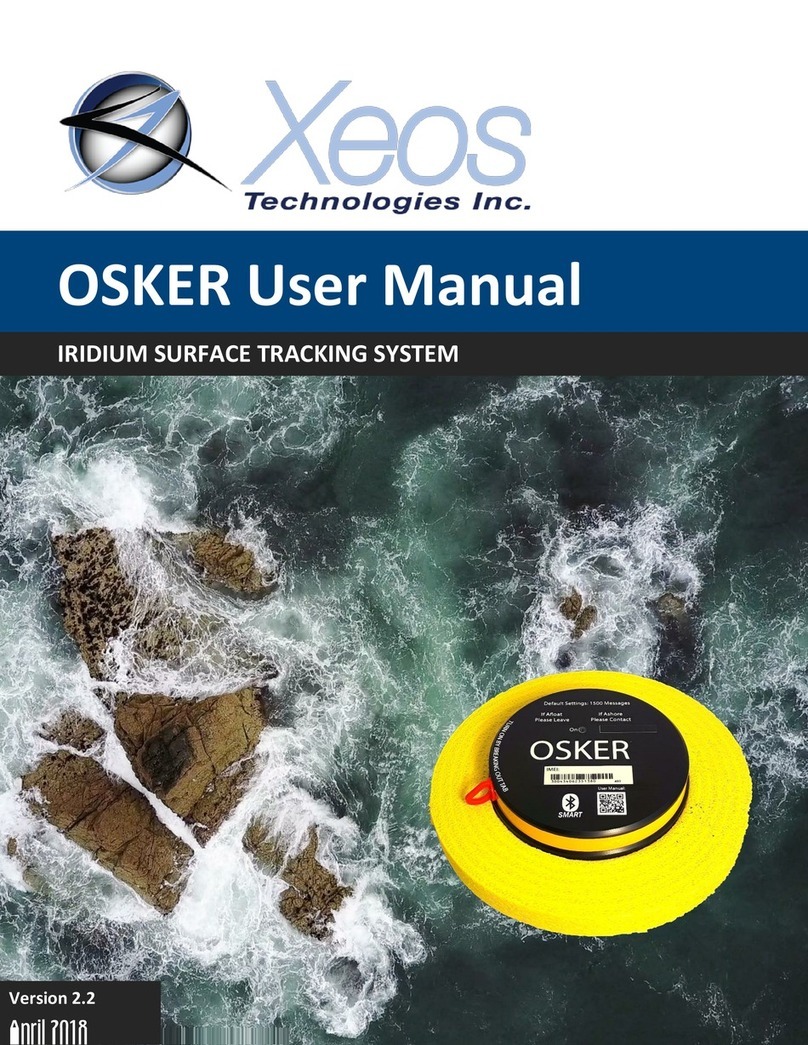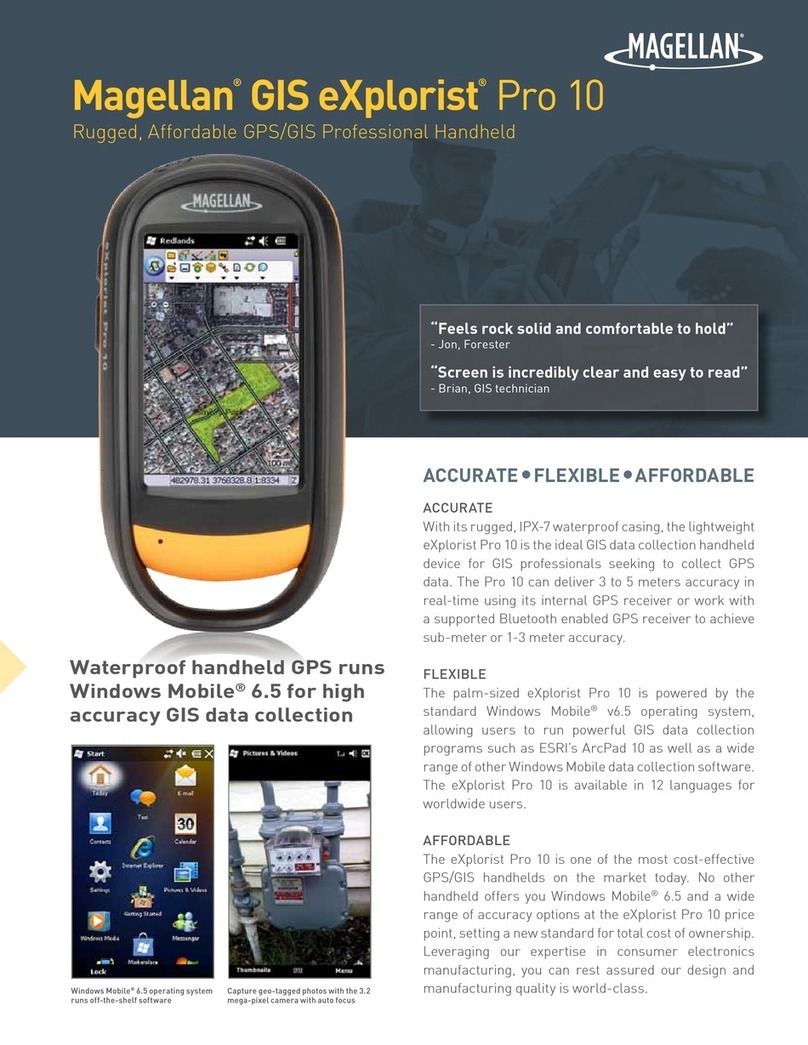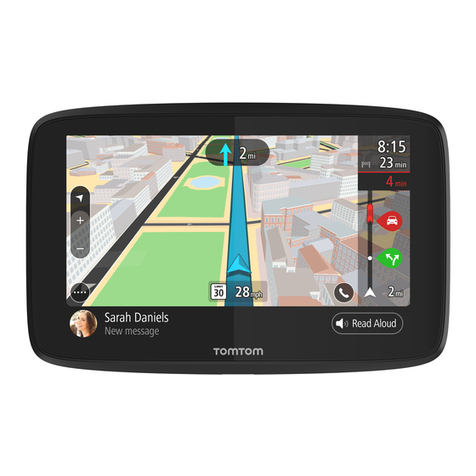SEQUANS Monarch Go-GPS BLE Quick setup guide

Sequans Monarch Go-GPS BLE
Datasheet
and
Hardware Integration Guide
Application Note - Revision 1.0
SEQUANS Communications
Les Portes de la Défense –Hall A
15-55 Boulevard Charles de Gaulle
92700 Colombes - France
Phone. +33.1.70.72.16.00
Fax. +33.1.70.72.16.09
www.sequans.com

Confidential and Proprietary
Monarch Go-GPS-BLE Datasheet and Hardware Integration Guide, Rev 1
2/28
Legal Notices
Copyright© 2020, SEQUANS Communications
All information contained herein and disclosed by this document is confidential and the proprietary
property of SEQUANS Communications and all rights therein are expressly reserved. Acceptance of this
material signifies agreement by the recipient that the information contained in this document is
confidential and that it will be used solely for the purposes set forth herein. Acceptance of this material
signifies agreement by the recipient that it will not be used, reproduced in whole or in part, disclosed,
distributed, or conveyed to others in any manner or by any means –graphic, electronic, or mechanical,
including photocopying, recording, taping, or information storage and retrieval systems –without the
express written permission of SEQUANS Communications.
All Sequans’ logos and trademarks are the property of SEQUANS Communications. Unauthorized usage
is strictly prohibited without the express written permission of SEQUANS Communications.
All other company and product names may be trademarks or registered trademarks of their respective
owners. Products and services of SEQUANS Communications, and those of its licensees may be
protected by one or more pending or issued U.S. or foreign patents.
Because of continuing developments and improvements in design, manufacturing, and deployment,
material in this document is subject to change without notification and does not represent any
commitment or obligation on the part of SEQUANS Communications. SEQUANS Communications shall
have no liability for any error or damages resulting from the use of this document.
Document Revision History
Revision
Date
Description
1.0
July 2020
First edition

Confidential and Proprietary
Monarch Go-GPS-BLE Datasheet and Hardware Integration Guide, Rev 1
3/28
Table of Contents
Introduction...............................................................................................................................................4
1. Product Datasheet ............................................................................................................................4
1.1. General Description ....................................................................................................................4
1.2. Applications.................................................................................................................................4
1.3. System Architecture....................................................................................................................4
1.4. Mechanical Overview..................................................................................................................5
1.5. Product Characteristics...............................................................................................................6
1.6. Digital board-to-board connector ................................................................................................8
1.7. Electrical......................................................................................................................................9
1.8. Environmental.............................................................................................................................9
1.9. Mechanical drawings ................................................................................................................10
1.10. Label .........................................................................................................................................11
1.11. Certifications .............................................................................................................................11
1.12. Regulatory Approval .................................................................................................................11
1.12.1. FCC statement............................................................................................................................................... 11
1.12.2. IC Industry Canada Statement.......................................................................................................................12
1.13. Export Control Certification Number (ECCN) ...........................................................................13
2. Integration guideline........................................................................................................................14
2.1. Digital connector .......................................................................................................................14
2.2. Bluetooth Low Energy interface................................................................................................16
2.3. Physical integration...................................................................................................................17
2.3.1. Placement without flex cable.......................................................................................................................... 17
2.3.2. Placement with flex cable............................................................................................................................... 18
2.4. Functional testing......................................................................................................................18
2.5. Configuration.............................................................................................................................19
3. Verizon SIM sign-up procedure to activate ThingSpace IoT SIM...................................................20
4. Troubleshooting ..............................................................................................................................28
4.1. Replacing the SIM card.............................................................................................................28
4.2. Connecting a RF cable to LTE connector.................................................................................28

Confidential and Proprietary
Monarch Go-GPS-BLE Datasheet and Hardware Integration Guide, Rev 1
4/28
Introduction
This application note is intended to help customers to successfully integrate and test their product based
on Monarch Go-GPS BLE. It presents the datasheet of Monarch Go-GPS BLE device and the integration
guidelines for:
All interface requirements of Monarch Go-GPS BLE with customer’s host board and device
Tips and “how-to”s for testing and troubleshooting
Verizon ThingSpace IoT SIM activation
This document summarizes product datasheet and proposes a development process aiming at reaching
optimal performance and quality of customer’s design. It is recommended to follow the steps in the order
presented in this document.
This document is divided in three sections:
Product datasheet
Integration guidelines and functional testing
Verizon sign-up procedure to activate ThingSpace IoT SIM Troubleshooting
1. Product Datasheet
1.1. General Description
Monarch Go-GPS BLE connected by Verizon is a comprehensive modem component offering device
makers the shortest possible route to market and lowest total cost of ownership (TCO) to develop a
cellular-IoT connected device. Unlike traditional cellular modules, it is certified by Verizon as an end-
device avoiding costly lab testing while improving time-to-market thanks to a reduced effort for board
design. It completely removes the need to design and tune a cellular antenna as it embeds an optimized
LTE antenna, saving months of design effort and lab testing. Monarch Go-GPS-BLE comes with a pre-
installed ThingSpace IoT SIM and gives device makers the simplest, easiest, and most cost-effective
solution for developing IoT devices for operation on Verizon’s network --- simply plug it in and go.
1.2. Applications
Monarch Go-GPS BLE is perfectly suited for a broad range of IoT applications, including telemetry,
vending machines, agriculture sensor applications, asset and transportation trackers, hardware tools, and
home security monitoring applications.
1.3. System Architecture
Customer IoT devices are typically designed with a MCU and a set of sensors. This MCU connects to
Monarch Go-GPS BLE through an UART interface
and can exchange data with a cloud server using
Verizon LTE network. The cloud server and the
MCU are where the customer application runs.
Verizon ThingSpace platform provides managed
billing, FOTA, device diagnostic and location
service(1) for Monarch Go-GPS BLE.
(1)Contact Verizon for service availability

Confidential and Proprietary
Monarch Go-GPS-BLE Datasheet and Hardware Integration Guide, Rev 1
5/28
1.4. Mechanical Overview
Monarch Go-GPS BLE dimensions: 35 mm (1.38”) x 50 mm (1.97”) x 14.95 mm (0.59”)
Plastic enclosure, black color
Fixable with two M2 screws and two metal nuts soldered on customer’s PCB. They are delivered
when ordering Monarch Go-GPS BLE
Verizon ThingSpace SIM pre-installed (3FF)
Embedded LTE & GNSS & Bluetooth low energy antenna
Three LEDs, one for LTE-M1 modem activity, one for GPS activity and one for BLE
Low profile 20-pin digital board-to-board connector to connect customer MCU application
controller
Optional board-to-board flex cable 150 mm (5.9“) between Monarch Go-GPS BLE and customer
MCU application board. Orderable separately
16 g weight
Monarch Go-GPS BLE : Top view Monarch Go-GPS BLE : Bottom view
Board-to-board flex cable (optional)
M2 screws
LTE, GPS, BLE LED
Metal nuts
Digital
board-to-board
connector
SIM cover
Connector
to customer MCU application board
Connector
to Monarch Go-GPS BLE

Confidential and Proprietary
Monarch Go-GPS-BLE Datasheet and Hardware Integration Guide, Rev 1
6/28
1.5. Product Characteristics
LTE with internal
antenna
Release 13 Cat-M1, 375 kbps uplink and 300 kbps downlink (peak)
Band 13
(700c)
TRP: 16dBm(1)
TIS: -99dBm(1)
Band 4
(1700/2100 AWS)
TRP: 18dBm(1)
TIS: -100dBm(1)
Radiation pattern
Omnidirectional
Polarization
Linear
GPS with
internal antenna
Band
L1
Sensitivity
Tracking -162 dBm; Acquisition -148
dBm
Modes
MSB: supported
MSA: not supported
Standalone GPS: will be available in
next software version
Antenna radiation pattern
Omnidirectional
Antenna polarization
Polarized
Bluetooth LE
with internal
antenna
Band
2.4GHz ISM (2402 MHz 2480 MHz)
Bluetooth Low Energy radio interface
v4.2 for controlling Monarch Go-GPS
BLE with AT commands and virtual
UART interface on host side
Antenna radiation pattern
Omnidirectional
Antenna polarization
Linear
PSM
Default value
Disabled
eDRX
Default value
Disabled
RRC Idle
Default value
Set by network - 1.28s cycle
cDRX
Disabled
SMS
Send and receive SMS in RRC Idle, eDRX and PSM mode.
APN
Default value
Set by network
IPV4V6
SUPL (2)
Default value
Disabled
Verizon
Thingspace
Supported services
LWM2M: FOTA, diagnostics, Precise
Location Services(2)
Roaming
Default value
Disabled
Modem control
from external
MCU
support for UDP, TCP, TFTP, FTP, HTTP, HTTPS, MQTT or MQTTS through
AT commands
SIM
Verizon ThingSpace IoT SIM card pre-installed, 3FF
LED
Default value
LTE activity
GPS activity
BLE activity
Digital board-to-
board connector
Connector type
Low profile 20-pin digital board-to-board
connector to connect to customer’s host
board

Confidential and Proprietary
Monarch Go-GPS-BLE Datasheet and Hardware Integration Guide, Rev 1
7/28
Notes:
(1) TIS/TRP performance is met when design recommendations are followed for optimal antenna
placement. These values are applicable to A3 hardware version.
(2) Additional charges might apply. Contact Verizon for service availability.
The below table summarizes the product reference orderable online from Avnet
(https://www.avnet.com/shop/us/m/sequans-communications/) or Sequans for direct customers:
User interface (1.8V)
UART 4-wires interface (RXD, TXD,
RTS, CTS) is the physical interface for
controlling Monarch Go-GPS BLE from
an external processor, typically a MCU,
with AT commands. The default
baudrate is 115200bps with hardware
flow control (RTS/CTS)
RING signals the availability of URC
from Monarch Go-GPS modem and can
be used to wake-up the MCU on the
host board
WAKE, POWER_STATUS: these
functions are disabled and not used.
Debug interface (1.8V, 3.1V)
UART2 2-wires interface (RXD/TXD)
with default baudrate of 115200bps for
LTE modem console port. Hardware
flow control RTS/CTS is disabled by
default. This interface is 1.8V.
GPS_UART1 2-wires (RXD/TXD) with
default baudrate of 115200bps
configured for GPS console port. There
is no signal for hardware flow control
RTS/CTS. This interface is 3.1V
Avnet orderable
reference
Sequans orderable
part number
Item description
Hardware
version
UE software
version
Product status
MONARCH-Go-GPS-
BLE-STK
GM01Q-Go-GPS-BLE-
A4
Monarch Go-GPS
BLE
Starter Kit
A3
SR1.2.0.0-10867
Volume
production
MONARCH-Go-GPS-BLE
GBA3NAZQZZ
Monarch Go-GPS
BLE modem
component with two
M.2 screws and nuts
A3
SR1.2.0.0-10867
Volume
production
Will be provided in a future edition of the document
150mm flex cable
n/a
Not applicable
Volume
production

Confidential and Proprietary
Monarch Go-GPS-BLE Datasheet and Hardware Integration Guide, Rev 1
8/28
1.6. Digital board-to-board connector
Notes :
(1) The pin number “1” is located on the side nearest the outer edge of the plastic case as
described below:
(2) "O" in this column means that a pull-up to an always-on voltage supply (Power group) with
typical 100kOhm resistor is an option:
- It is mandatory for designing a compatible host board hosting either Monarch Go-GPS,
Monarch Go-GPS BLE or Monarch Go (LTE only) version, at a degraded standby current.
- If the host board is only for Monarch Go-GPS or Monarch Go-GPS BLE, pull-up resistors
are not needed.
See section 2.1 for more details.
(3) Note the pin characteristics (name, function, …) of the pin number 16 to 20 are different versus
the digital board-to-board connector of the Monarch Go (LTE Only) version.
Pin number (1)(3) Direction Pin name Function Description
Power
group
State
@reset
Pull-up on
host board (2)
1IN VCC Power supply Voltage level 3.1V to 5.5V n/a n/a
2IN GND Ground n/a n/a
3IN GND Ground n/a n/a
4IN nRESET Reset Reset signal. Active low. 3.1V In, PU O
5IN UART1_TXD Main UART1 TXD Main UART: Host board sends data to Monarch Go-GPS. 1.8V In, PU
6 OUT UART1_RXD Main UART1 RXD Main UART: Monarch Go-GPS sends data to Host board. 1.8V In, PU
7IN UART1_RTS Main UART1 RTS
Main UART: Hardware flow control signals. Active low. UART1_RTS i s
used to wake-up Monarch Go-GPS from Host board.
1.8V In, PU O
8 OUT UART1_CTS Main UART1 CTS 1.8V In, PU O
9 OUT RING RING si gnal
This si gnal indicates a URC from Monarch Go-GPS and shal l be read
by host board. Active low.
1.8V In, PU O
10 IN WAKE Wake-up signal Disabled by defaul t. Connect to headers. 1.8V In, PD
11 OUT POWER_STATUS Power Saving Status Disabled by default. Connect to headers. 1.8V In, PD
12 IN UART2_TXD Debug UART2 TXD 1.8V In, PU
13 OUT UART2_RXD Debug UART2 RXD 1.8V In, PU
14 IN UART2_RTS Debug UART2 RTS 1.8V In, PU
15 OUT UART2_CTS Debug UART2 CTS 1.8V In, PU
16 OUT GPS_UART1_RXD Debug GPS UART1 RXD 3.1V In, PU
17 IN GPS_UART1_TXD Debug GPS UART1 TXD 3.1V In, PU
18 n/a DNC18 Do not connect 1.8V In, HiZ
19 OUT GPS_UART2_RXD Do not connect 3.1V In, PU
20 IN GPS_UART2_TXD Do not connect 3.1V In, PD
Monarch Go-GPS board-to-board connector
reference: MOLEX 53916-0208
Debug UART2: Hardware flow control signals. Di sabled by default.
Connect to headers.
Debug GPS_UART1. Data for GPS console . Connect to headers.
Debug UART2. Data for LTE modem console. Connect to headers.
Used internally, do not connect, keep floating.

Confidential and Proprietary
Monarch Go-GPS-BLE Datasheet and Hardware Integration Guide, Rev 1
9/28
1.7. Electrical
VCC:
oOperating voltage supply min 3.1 V - max 5.5 V
oVCC power supply dimensioning peak 2.0 W
DC characteristics for digital I/O1.8V power group (main UART1, debug UART2 and other 1.8V
signals)
oVIH Input High level voltage min 1.26 V - max 3.6V
oVIL Input Low level voltage min 0 V –max 0.45VVOH Output
High level voltage min 1.35 V - max 1.8V
DC characteristics for digital I/O 3.1V power group (debug GPS_UART1)
oVIH Input High level voltage min 2.0 V - max 3.6V
oVIL Input Low level voltage min -0.3 V - max 0.8V
oVOH Output High level voltage min 1.35 V - max 1.8V
Power Consumption (typical, VCC=3.8 V; when a range is given, average value depends on
radio condition and LED activity )
oDeep sleep mode, PSM 35uA
oeDRX 81.92s 0.5-1.3m A
oRRC Idle 1.28s 3.3-6.2mA
oReceive, max throughput 150mA
oTransmit, max throughput, +23dBm 230mA
1.8. Environmental
Compliant with RoHS directive EU 2015/863
Temperature
oOperating (board) -40° C to +80° C
oRF compliant (ambient) -30° C to +60° C
oStorage -40° C to +85° C
Humidity
oOperating 10% to 85% (non condensing)
oStorage 5% to 85% (non condensing)

Confidential and Proprietary
Monarch Go-GPS-BLE Datasheet and Hardware Integration Guide, Rev 1
10/28
1.9. Mechanical drawings
Monarch Go-GPS BLE –A3 hardware version
(dimension in mm)
150mm flex cable (dimension in mm)

Confidential and Proprietary
Monarch Go-GPS-BLE Datasheet and Hardware Integration Guide, Rev 1
11/28
1.10. Label
The following identities are marked on a 30x12mm heat resistant label on Monarch Go-GPS BLE device:
1.11. Certifications
The certifications apply to Monarch Go-GPS –A3 hardware version.
Verizon
certification
Verizon Open Development Device Certification
LTE cat-M1, band 13 and band 4
Certification ID: 13215
Regulatory
approval
FCC part 15 / ISED
LTE band 13 and band 4
FCC-ID: 2AAGMGMQGOB
IC: 12732A-GMQGOB
1.12. Regulatory Approval
1.12.1. FCC statement
Changes or modifications not expressly approved by the party responsible for compliance could void the
user’s authority to operate the equipment.
This device complies with part 15 of the FCC Rules. Operation is subject to the following two conditions:
(1) This device may not cause harmful interference, and (2) this device must accept any interference
received, including interference that may cause undesired operation.
RF exposure safety
This device complies with the FCC RF exposure limits and has been evaluated in compliance with mobile
exposure conditions.
The equipment must be installed and operated with minimum distance of 20 cm of the human body.
Class B device notice
Note: This equipment has been tested and found to comply with the limits for a Class B digital device,
pursuant to part 15 of the FCC Rules. These limits are designed to provide reasonable protection against
harmful interference in a residential installation. This equipment generates, uses and can radiate radio
frequency energy and, if not installed and used in accordance with the instructions, may cause harmful
interference to radio communications. However, there is no guarantee that interference will not occur in a
particular installation. If this equipment does cause harmful interference to radio or television reception,
which can be determined by turning the equipment off and on, the user is encouraged to try to correct the
interference by one or more of the following measures:

Confidential and Proprietary
Monarch Go-GPS-BLE Datasheet and Hardware Integration Guide, Rev 1
12/28
—Reorient or relocate the receiving antenna.
—Increase the separation between the equipment and receiver.
—Connect the equipment into an outlet on a circuit different from that to which the receiver is
connected.
—Consult the dealer or an experienced radio/TV technician for help.
1.12.2. IC Industry Canada Statement
Changes or modifications not expressly approved by the party responsible for compliance could void the
user’s authority to operate the equipment.
Les changements ou modifications non expressément approuvés par la partie responsable de la
conformité peuvent annuler le droit de l'utilisateur à utiliser l'équipement.
This device complies with ISED license-exempt RSS(s). Operation is subject to the following two
conditions: (1) This device may not cause harmful interference, and (2) this device must accept any
interference received, including interference that may cause undesired operation.
Cet appareil est conforme aux RSS exempts de licence d'ISDE. Son fonctionnement est soumis aux deux
conditions suivantes: (1) Cet appareil ne doit pas provoquer d'interférences nuisibles et (2) cet appareil
doit accepter toute interférence reçue, y compris les interférences susceptibles de provoquer un
fonctionnement indésirable.
Permitted Antenna
This radio transmitter has been approved by the ISED to operate with the internal antenna listed below
with the maximum permissible gain indicated. Antenna types not included in this list, having a gain
greater than the maximum gain indicated for that type, are strictly prohibited for use with this device.
Cet émetteur radio a été approuvé par l'ISDE pour fonctionner avec l’antenne interne listée ci-dessous
avec le gain maximum autorisé indiqué. Les types d'antennes non inclus dans cette liste, ayant un gain
supérieur au gain maximum indiqué pour ce type, sont strictement interdits pour une utilisation avec cet
appareil.
South Star Technology, SV90 LTE antenna
Licensed bands
Max Gain
Band 4
2 dBi
Band 13
0 dBi
RF exposure safety
This device complies with ISED RF exposure limits and has been evaluated in compliance with mobile
exposure conditions.
Cet appareil est conforme aux limites d'exposition RF d'ISDE et a été évalué conformément aux
conditions d'exposition mobile.
The equipment must be installed and operated with minimum distance of 20 cm of the human body.
L'équipement doit être installé et utilisé à une distance minimale de 20 cm du corps humain.
CAN ICES-003 (B)

Confidential and Proprietary
Monarch Go-GPS-BLE Datasheet and Hardware Integration Guide, Rev 1
13/28
This Class B digital apparatus complies with Canadian ICES-003
Cet appareil numérique de classe B est conforme à la norme ICES-003 du Canada
1.13. Export Control Certification Number (ECCN)
ECCNs are five character alpha-numeric designations used on the Commerce Control List (CCL) to
identify dual-use items for export control purposes. An ECCN categorizes items based on the nature of
the product, i.e. type of commodity, software, or technology and its respective technical parameters.
ECCN of Monarch Go-GPS is 5A992.c. CCATS number is G175554.
The following comment from licensing officer is reported on the license information:
This encryption item is described in paragraph B to note 3 (mass market note) of category 5 part
2. It is authorized for export and re-export under section 740.17(B)(3) of the export administration
regulations (EAR).

Confidential and Proprietary
Monarch Go-GPS-BLE Datasheet and Hardware Integration Guide, Rev 1
14/28
2. Integration guideline
2.1. Digital connector
Monarch Go-GPS BLE device can interface to the Host Board through a board-to-board digital connector:
Customer shall design a host board with the connector part number 54167-0208 from Molex as
described in below figure. The datasheet can be obtained searching Molex web site
(https://www.molex.com) with this part number.
Monarch Go-GPS is equipped with a digital connector, its part number is 53916-0208 from Molex
The below diagram is an example of host board implementation:
Example schematic of host board with Molex 54167-0208 connector to connect Monarch Go-GPS BLE
The mandatory electrical interfaces between Monarch Go-GPS BLE and the host board are:
Supply (VCC) min 3.1 V - max 5.5 V. The supply shall support up to 2 Watts peak even if the
average power consumption is significantly lower.
Ground
nRESET: Monarch Go-GPS BLE device will reset every time this signal goes low.
oIf this signal is connected to a MCU, the MCU GPIO shall be configured as open drain as
there is an internal pull-up in Monarch Go-GPS BLE.
oIf this signal is connected to a switch, having a pull-up resistor on host board is not
mandatory as there is an internal pull-up in Monarch Go-GPS BLE.
Warning: The host board design for Monarch Go-GPS BLE is not compatible with Monarch Go if there is
no pull-up to an always-on supply on host board.
UART1 4-wires interface (RXD, TXD, RTS, CTS) is the main physical interface for controlling
Monarch Go-GPS BLE from an external processor, typically a MCU. The default configuration is:

Confidential and Proprietary
Monarch Go-GPS-BLE Datasheet and Hardware Integration Guide, Rev 1
15/28
oBaud rate : 115200
oData : 8 bit
oParity : None
oStop : 1 bit
oFlow control : hardware (RTS/CTS)
RING signals the availability of URC from Monarch Go-GPS BLE modem and can be used to
wake-up the MCU on the host board
Warning: The host board shall be compliant with below high voltage level:
oVIH Input High Voltage (UART1 TXD/RTS) min 1.26 V - max 3.6V
oVOH Output High Voltage (UART1 RXD/CTS and RING) min 1.35 V - max 1.8V
If the MCU on host board is capable of 3V only but not 1.8V, level shifters shall be added on
UART1 RXD, CTS and RING.
The below electrical signals on Monarch Go-GPS shall BLE be connected to test points on host board for
debug purpose:
UART2 2-wires RXD/TXD is the LTE modem console port. Default configuration :
oBaud rate : 115200
oData : 8 bit
oParity : None
oStop : 1 bit
oFlow control : None (no RTS/CTS)
Note: hardware flow control (RTS/CTS) is disabled by default even if signals are present on the
connector.
Warning: the high voltage levels for these signals are:
oVIH Input High Voltage (UART2 TXD/RTS) min 1.26 V - max 3.6V
oVOH Output High Voltage (UART2 RXD/CTS) min 1.35 V - max 1.8V
GPS_UART1 2-wires RXD/TXD is configured for GPS console. Default values:
oBaud rate : 115200
oData : 8 bit
oParity : None
oStop : 1 bit
oFlow control : None (no RTS/CTS)
Warning: the high voltage levels for these signals are:
oVIH Input High level voltage min 2.0 V - max 3.6V
oVOH Output High level voltage min 2.9 V - max 3.3V
WAKE and POWER_STATUS: These functions are disabled by default.
Note: the high voltage levels for these signals are:
oVIH Input High Voltage (WAKE and POWER_STATUS) min 1.26 V - max 3.6V
oVOH Output High Voltage (WAKE and POWER_STATUS) min 1.35 V - max 1.8V

Confidential and Proprietary
Monarch Go-GPS-BLE Datasheet and Hardware Integration Guide, Rev 1
16/28
2.2. Bluetooth Low Energy interface
Monarch Go-GPS BLE allows the user to send AT commands from the MCU to the product via BLE (on
top of physical UART already supported).
The product acts only as a BLE slave. It connects automatically and securely to a single master.
Just after boot, Monarch GO-GPS BLE automatically enters into an advertising mode to allow the master
to discover it.
The scanning is requested by the master and Monarch Go-GPS BLE will answer to the requested
messages. Master and slave wil then start the auto connection establishment procedure.
Monarch-Go-GPS BLE device naming convention is defined as per the following:
GM01Q-GO-GPS-BLE-<last 7 digits of serial number of the device>
oExample : GM01Q-GOGPS-BLE0002005
When the end user will have to pair his device, he will have to entre 6 digit pairing key. Digit key is
composed by the 6 last IMEI digits from the device.
Once connected, device emulates service for UART interface. Monarch Go-GPS-BLE is implementing a
BLE GATT server.
Monarch-Go-GPS BLE supports a single master: once a master is connected, the product will stop
advertising to other masters and will not accept new connections from other masters until the connected
master release the connection.
If master disconnects from slave either voluntary with an AT command or involuntary because of radio
link quality, the slave goes back to advertising mode automatically and wait for a master to discover it.

Confidential and Proprietary
Monarch Go-GPS-BLE Datasheet and Hardware Integration Guide, Rev 1
17/28
2.3. Physical integration
2.3.1. Placement without flex cable
When Monarch Go-GPS BLE is connected directly on host board, the host board shall be designed with
2 holes to solder the M.2 nuts
the board-to-board connector
An example of placement on host board is illustrated below:
Host board (top view):
without Monarch Go-GPS BLE (left) and with Monarch Go-GPS BLE (right)
The M.2 nuts are made of metal and are aimed at ensuring physical and grounding connection between
the host board and Monarch Go-GPS BLE thanks to two M.2 screws and nuts.
M.2 nut and M.2 screw
Note: the two M.2 screws and nuts are delivered when ordering Monarch Go-GPS BLE (GBA3NAZQZZ).
The exact position of the drilled holes and the connector on Host Board shall match the dimensions given
in document “Monarch Go-GPS Mechanical drawing-2d-enclosure-drawing- 20190905_A2.1.pdf”.
Placement on host Board is critical to correctly fit Monarch Go-GPS BLE to the host Board.
The dimension of the M.2 nuts are given in document “NDA-Monarch Go-Mechanical drawing-
2d-SMT-NUT-M2x4_A2.1.pdf”. The nuts are shipped with Monarch Go-GPS .

Confidential and Proprietary
Monarch Go-GPS-BLE Datasheet and Hardware Integration Guide, Rev 1
18/28
The dimension of the M.2 screws are given in document “NDA-Monarch Go-Mechanical drawing-
2d-Screw-M2X4-Model_A2.1.pdf”. The screws are shipped with Monarch Go-GPS .
The footprint of the connector 54167-0208 is given in Molex datasheet available from their web
site. Note: customer can add anti vibration thread locking adhesive to the 2 screws for higher
resistance to vibration.
Warning: In order to get optimal antenna performance, no metal plate shall be located above Monarch
Go-GPS BLE embedded LTE antenna as described on this figure:
2.3.2. Placement with flex cable
The optional flex cable can be used between the connector of the Host Board and the connector of
Monarch Go-GPS BLE, allowing positioning Monarch Go-GPS BLE away of the host board.
The position of the connector on the Host Board does not have to follow the guidance of section
2.2.1 when the flex cable is used, it gives more flexibility in Host Board design.
In order to get optimal antenna performance, the design shall follow below guidelines:
It is recommended to solder the nuts to a large PCB with ground plane
If this is not possible, the nuts shall be soldered to wires connected to ground. The objective is to
improve grounding connection between Monarch Go-GPS BLE PCB and an external ground
plane, for optimal antenna performance.
The best position of Monarch Go-GPS BLE device into the end product can be estimated by
using AT command AT+CSQ that reports signal strength. The position with lowest value (highest
signal strength) is the best one.
Warning: In order to get optimal antenna performance, no metal plate shall be located above Monarch
Go-GPS BLE embedded LTE antenna as described on this figure:
2.4. Functional testing
Once Monarch Go-GPS BLE is correctly assembled to the Host Board, AT command interface through
physical UART connected to external MCU or Bluetooth radio interface can be used for functional testing.
Sending AT command “ATI1” to UART1 will return Monarch Go-GPS BLE software version:

Confidential and Proprietary
Monarch Go-GPS-BLE Datasheet and Hardware Integration Guide, Rev 1
19/28
UE5.2.0.1
SR1.2.0.0-xxxx
LR5.2.1.0-yyyy
This will verify that the UART1 connection between Host Board MCU and Monarch Go-GPS BLE is
functional and correctly configured (voltage level, baud rate, hardware flow control).
The next step is to verify connectivity to Verizon network, this can be done typing
AT+PING=www.sequans.com command.
2.5. Configuration
The default LTE LED behavior can be changed using AT+SQNLED, this is a persistent setting.
AT+SQNLED=0 : Set LTE blink mode Off. The LTE LED is switched off.
AT+SQNLED=1 : Set blink mode On. The LTE LED will blink according to the system state:
oAT+CFUN=0 or 4. The modem is stopped or in Airplane mode. The LED is permanently
turned off.
oAT+CFUN=1. LTE data transfer. The LTE LED is permanently turned on.
oAT+CFUN=1. The modem is registered to the network, no data transfer (modem is in
RRC Idle). The LTE LED blinks (typically 1280 ms on, 19200 ms off).
oAT+CFUN=1. Limited Network Service (no SIM, network search). The LED blinks
(typically 500 ms on, 500 ms off).
oAT+CFUN=1. The modem is in sleep or deep sleep mode (eDRX or PSM). The LTE LED
is permanently turned off.
AT+SQNLED=2 : Set GPS blink mode Off. The GPS LED is switched off.
AT+SQNLED=3 : Set GPS blink mode On. The GPS LED will blink according to the system state:
the GPS is active (1000ms on, 2000ms off)
AT+SQNLED=4 : Set BLE blink mode Off. The BLE LED is switched off.
AT+SQNLED=5 (default): Set BLE blink mode On. The BLE LED will blink according to the
system state. Note that enabling BLE LED will prevent Monarch Go-GPS BLE to go in deep sleep
mode during advertising mode.

Confidential and Proprietary
Monarch Go-GPS-BLE Datasheet and Hardware Integration Guide, Rev 1
20/28
3. Verizon SIM sign-up procedure to activate ThingSpace
IoT SIM
In order to sign-up to the VzW ThingSpace portal, you can go to the web page:
https://thingspace.verizon.com/start
Note: for security reason, Verizon sign-up procedure requires to have a USA mobile phone number to
receive the mobile passcode from Verizon through SMS. Without this, you cannot activate the SIM pre-
installed in Monarch Go-GPS BLE. Contact Verizon for further assistance.
Then follow the below procedure.
Step 1: Start the Signup procedure
Step 2: select the ThingSpace signup procedure
Table of contents
Other SEQUANS GPS manuals
